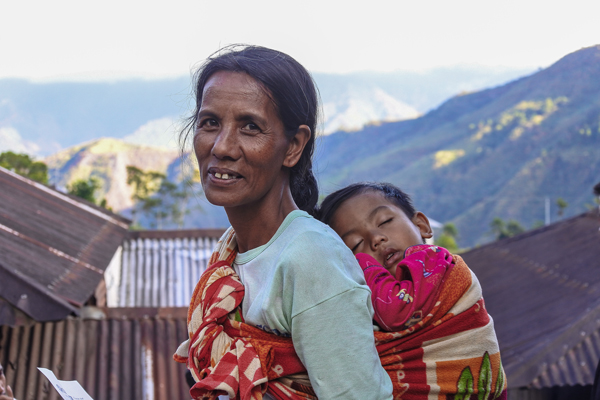
Supporting Marawi recovery into 2019
Government-led rehabilitation and recovery is underway in the most affected areas in Marawi City, following a groundbreaking ceremony on 30 October and demolition of destroyed structures in November. The private company undertaking the demolition and debris clearing was later put temporarily on hold, pending permits and further consultations by Task Force Bangon Marawi with homeowners. Work to clear barangays in Sector 1 is reportedly scheduled to be completed March 2019.
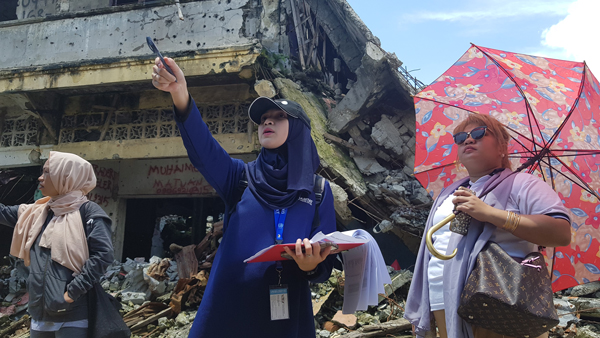
Credit: UN-Habitat Marawi City, Lanao del Sur (7 November 2018) - UN-Habitat field staff conducts ground validation in Marawi's most affected areas. Families prioritized for shelter provision eligibility of the Rebuilding Marawi Shelter and Livelihood Project are those living in the three to six metre easement of Lake Lanao and Agus river and those from vulnerable groups. Marawi authorities recently announced an initial list of eligible families.
Financing recovery and rehabilitation
The Philippines Government has devised several strategies to fund the reconstruction of Marawi City’s most affected areas, led by the Department of Finance. International and private sector partners have pledged funding towards the Government’s Bangon Marawi Comprehensive Rehabilitation and Recovery Program (BMCRRP) including such as Australia, China, Germany, Japan, Korea, Spain, and the United States. The Asian Development Bank announced on 14 December a US$408 million financing package which includes a loan to finance programmes under the BMCRRP, the reconstruction of roads and infrastructure and grants towards rehabilitating water supply systems, rebuilding health facilities, and scaling up education and livelihood programmes. Other international development and recovery partners acknowledged in a statement by the Department of Finance include the World Bank, the International Fund for Agricultural Development (IFAD) as well as the United Nations. Private sector partners under the Philippine Disaster Resilience Foundation are also working with provincial authorities in supporting rehabilitation efforts and is rolling out water supply projects in Marawi City schools.
Peace and security situation
A majority vote in the Philippine Senate and Congress approved the extension of Martial Law in Mindanao until the end of 2019. This is the third extension, which was initially declared by President Rodrigo Duterte following the start of the Marawi Conflict in May 2017. In a letter to Congress, President Duterte cited the continuing hostile activities of non-state armed groups in Mindanao as a basis for requesting for the extension.
Expanding the peace process in Mindanao is a key priority of the Government. Peace and security has been fragile in Mindanao for over four decades and has been a barrier to economic progress and sustainable development in the region. Republic Act 11054 or the Bangsamoro Organic Law, is central to the peace process with non-state armed groups and was signed into law by President Duterte in July. The Bangsamoro Organic Law, intended to create a region to replace the Autonomous Region in Muslim Mindanao (ARMM), will be subject to a plebescite on 21 January (for voters from the five provinces of ARMM – Maguindanao, Lanao del Sur, Basilan, Sulu, Tawi-Tawi and the cities of Cotabato and Isabela. A second date, 6 February, will be for voters in Lanao del Norte, North Cotabato and other areas that petitioned for inclusion in the proposed new entity to be known as the Bangasamoro Autonomous Region of Muslim Mindanao (BARMM).
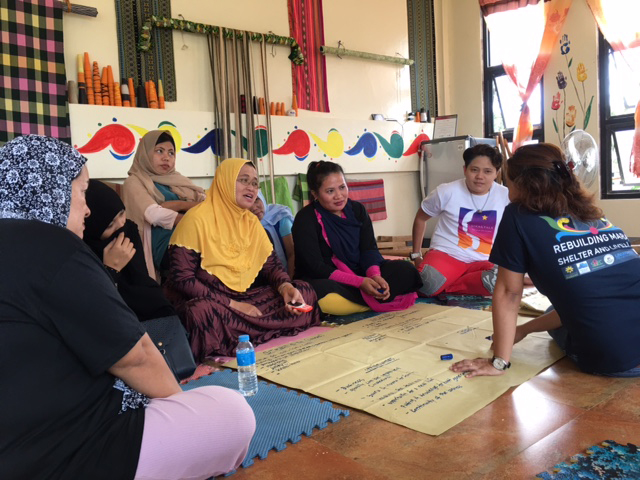
Marawi City, Lanao del Sur (7 November 2018) - A focus group discussion on livelihood assessment with Marawi weavers. The initiative is part of the Rebuilding Marawi Shelter & Livelihood Recovery Project of UN-Habitat together Marawi City and national government agency Social Housing Finance Corporation.
Seeking durable solutions for Marawi displaced
As of 28 October, over 73,000 people remain displaced, with most staying with host families while others are either in evacuation centres or temporary shelters. According to the Protection Cluster, which is co-led by UNHCR and the Department of Social Welfare and Development, humanitarian needs that were voiced by Marawi IDPs include food assistance, livelihood support, and compensation for damaged homes and property. The United Nations High Commissioner for Refugees (UNHCR) is targeting assistance to over 12,000 people in a birth registration initiative, helping those who lost their civil documents as they were fleeing the conflict.
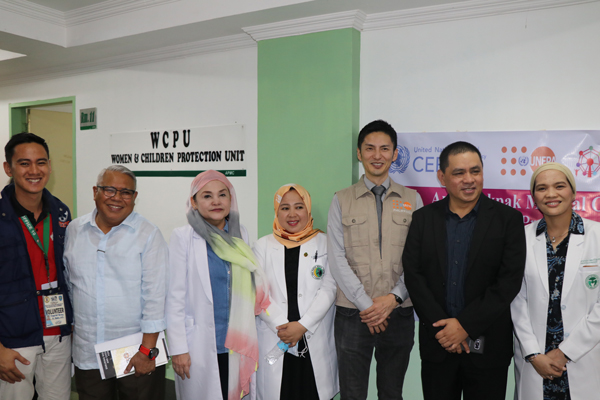
Credit: UNFPA/M. Villamor Marawi City, Lanao del Sur (7 November 2018) - To provide care to survivors of gender-based violence, the Department of Health, in partnership with the United Nations Population Fund and the Child Protection Network (CPN) Foundation, Lanao del Sur, and Marawi City Police established a Women and Children Protection Unit (WCPU) at Amai Pakpak Medical Center in Marawi City.
Humanitarian response strategy into 2019
The Humanitarian Country Team (HCT), composed of in-country UN agencies, international and local NGOs and the private sector, coordinates with the Government of the Philippines at the national and Mindanao level to support the priority humanitarian needs of people displaced and affected by Marawi conflict and coordinating with Regional, Provincial and Local Government Agencies to identify opportunities to assist in early recovery efforts. As humanitarian programmes under the United Nations Central Emergency Response Fund are completed at the end of 2018, the momentum of humanitarian assistance to complement Government-led recovery must continue.
The HCT and partners are revising the Humanitarian Response and Resource Overview document for the Marawi Conflict, as reflected in the 2019 Global Humanitarian Overview, to address the humanitarian and early recovery needs of about 300,000 beneficiaries in 2019 in support of the Government-led efforts. The response seeks to address residual humanitarian needs of the most vulnerable and displaced population and promote early recovery, protection, gender and culturally sensitive approaches as cross-cutting themes for all clusters. The HCT and partners are seeking $43.6 million, to respond to the humanitarian and early recovery needs of the displaced and returnee population in 2019.
The Humanitarian Country Team and partners are revising the Humanitarian Response and Resource Overview document for the Marawi Conflict to address the humanitarian and early recovery needs of about 300,000 beneficiaries in 2019, in support of the Government-led efforts.
With about a half billion US dollars in damages and losses to the local agricultural sector, and a mild to moderate El Niño event forecasted to affect northern Luzon in early 2019, much attention is being given to restoring the livelihoods of farmers.
The two storms also damaged at least 350,000 homes and destroyed over 31,400 more across northern Philippines, with Cagayan Valley in the northeast suffering the most housing losses.
Community consultations were crucial in planning cash distribution activities. This helped Christian Aid and its partners, for example, learn their beneficiaries wanted disbursements timed with ‘market days’ and in locations more convenient to them.
Recovery from typhoons in northern Philippines
Residents in northern and central Luzon are beginning to recover three months after Typhoon Mangkhut (locally named Ompong) and six weeks following Typhoon Yutu (locally named Rosita) devastated the regions.
According to the Department of Social Welfare and Development (DSWD), about 13,000 people in Region III (Central Luzon) are still staying with friends or relatives following the category-5 storm Mangkhut, with another 400 in evacuation centres, as of its last report on 6 November. Meanwhile, in its 18 November report on Typhoon Yutu, DSWD noted about 1,400 people remained displaced in the Cordilleras Administrative Region, including 315 people staying in evacuation centres in Itogon and Tuba, Benguet province. Typhoon Yutu, a category-4 storm, caused 440,000 people in central and northern Luzon to evacuate just before the Filipino tradition of Undas, when many people tend to their families’ graves on All Saints and All Souls Days.
To support the national and local response and early recovery efforts for these storms, the Philippines Humanitarian Country Team updated and expanded its humanitarian response and resources overview document in November to address the early recovery needs of 165,000 people through March 2019, for which it seeks US$31 million. To date, $4 million has been mobilized from the US, Australia, Germany, New Zealand, Denmark and Ireland. About 60 per cent of the $31 million requirement is needed for food security, agriculture and livelihoods.
Helping farmers restore their livelihoods
With about a half billion US dollars in damage and losses to the local agricultural sector, and a mild to moderate El Niño event forecasted to affect northern Luzon in early 2019, much attention is being given to restoring the livelihoods of farmers.
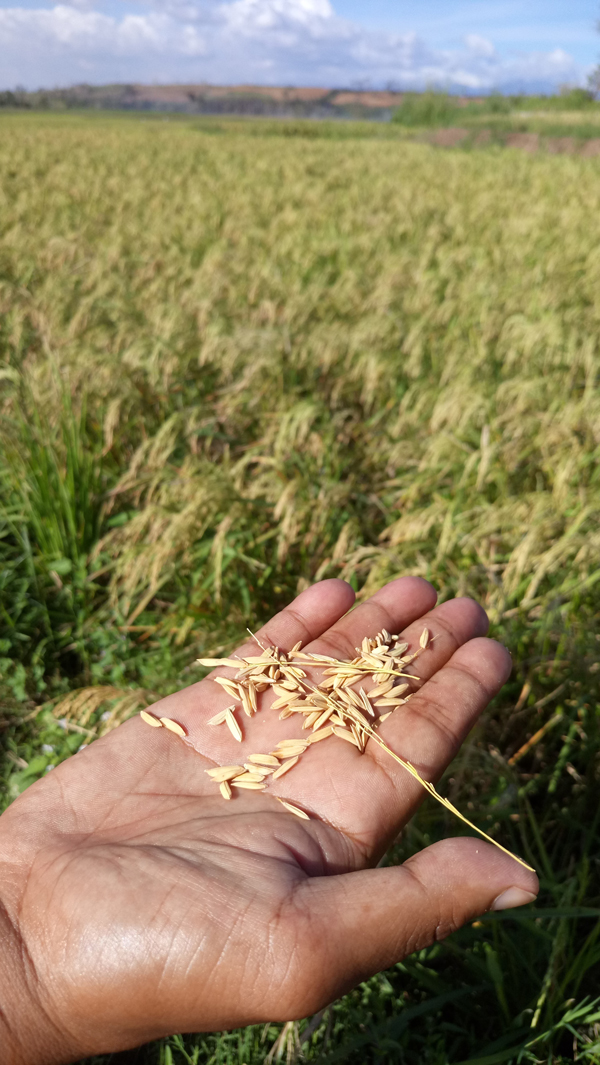
Credit: FAO Ilagan, Isabela (1 November 2018) - Forty to sixty per cent of rice grains are empty due to Typhoon Yutu's strong winds.
In November, the Australian Government provided AUD600,000 ($432,000) to restore the livelihoods and improve the security and nutrition of 2,000 affected farming families (about 10,000 people) in Cagayan province. The support, implemented in partnership with the United Nations Food and Agriculture Organization and the World Food Programme, will complement the Department of Agriculture’s initiatives to restore agricultural livelihoods and production through the distribution of inputs like fertilizers and seeds, training to resume income-generating activities, and cash-for-work interventions to address food security and nutritional needs.
Helping residents left homeless to rebuild their homes
The two storms also damaged at least 350,000 homes and destroyed over 31,400 more across northern Philippines, with Cagayan Valley in the northeast suffering the most housing losses. This region was still rebuilding from Typhoon Haima, which hit in 2016. Landslides caused by the heavy rains wreaked havoc in the mountainous provinces of the Cordilleras, also causing significant housing damages.
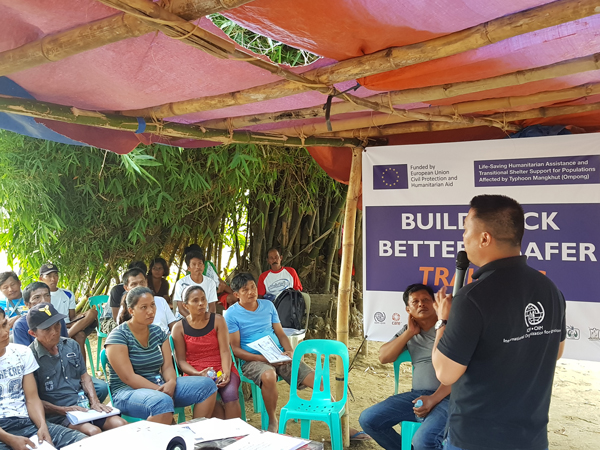
Credit: IOM/C. Natividad Amulong, Cagayan (28 November 2018) - An IOM engineer conducting a Build Back Better & Safer training to shelter beneficiaries and community members in Amulung, Cagayan. The training is given as social preparation for shelter repair kit distribution and repair work.
The International Organization for Migration (IOM) is among the organizations addressing shelter needs in Cagayan Valley and the Cordilleras. With funding from the European Union’s Civil Protection and Humanitarian Aid Operations (ECHO), IOM is providing transitional and recovery shelter solutions to over 1,700 families. Catholic Relief Services, with funding from USAID, and Christoffel Blindenmission (CBM) and World Vision also have ongoing shelter projects in those regions.
While IOM and other responders are working with local social welfare authorities, the National Housing Authority and the Mines and Geosciences Bureau to identify suitable building lots, one challenge they are encountering, particularly in Benguet, are areas declared “no-build zones” due to susceptibility to landslides. IOM held a workshop with the CARE Consortium in Baguio on 1 November to discuss the challenge. The consortium is committed to providing WASH support once the transitional sites are cleared.
Cash-based programming leads solutions toward early recovery
In the Philippines, as elsewhere cash-based interventions have been a successful option for people to quickly recover from natural disasters, especially where markets are functioning. In the responses to typhoons Mangkhut and Yutu, the Government, local and international NGOs and responding UN organizations have been disbursing cash to storm survivors for myriad purposes, including to subsidize rents for people repairing and rebuilding their homes and as unconditional cash assistance to meet whatever immediate needs of those who lost everything to the storms. Cash-for-work programmes implemented by social welfare authorities and humanitarian partners are another way affected populations have accessed the funds they need to restore their lives and livelihoods.
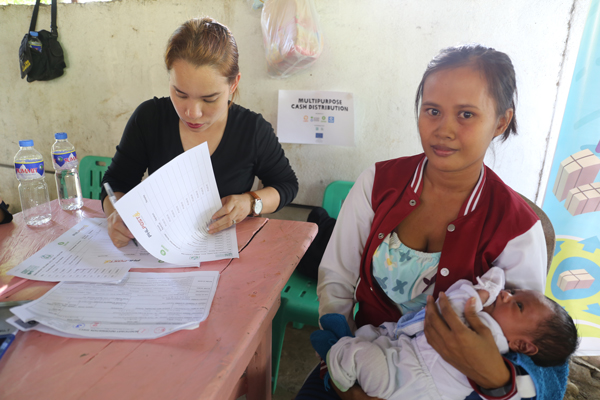
Credit: OXFAM/D. Balidoy Alcala, Cagayan (30 October 2018) - Women especially pregnant and lactating mothers are given prioritization during multi-purpose cash distribution by Oxfam and the Humanitarian Response Consortium to 700 families in Alcala.
Where possible, digital profiling and distribution systems are used to transfer cash to beneficiaries, but in remote areas, where digital banking options are limited or non-existent, direct cash payouts have been welcomed by recipients. In delivering cash assistance to remote communities, community-based organizations, cooperatives and church networks were best placed to reach those in need. International NGOs such as Christian Aid, Oxfam and CBM and national NGO networks like CODE-NGO and Humanitarian Response Consortium, continue to work with these local partners to deliver one-time cash payouts.
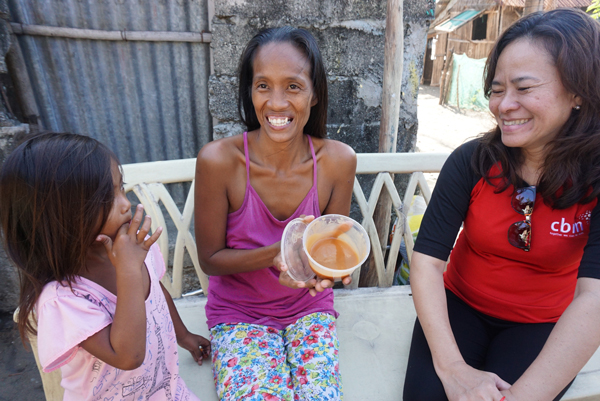
Credit: CBM/M. Nombrado Ilocus Sur (13 November 2018) - Maricel distributes dulce de leche spread in her community and helping her husband in their daily needs.
Community consultations were crucial in planning cash distribution activities. This helped Christian Aid and its partners, for example, learn their beneficiaries wanted disbursements timed with ‘market days’ and in locations more convenient to them. Engaging with local authorities helped build trust and ensure the security of both the aid workers and the beneficiaries.
Vulnerable and marginalized groups, members of the indigenous Agta tribe, persons with disabilities and elderly persons are often overlooked following disasters, and so some local, national and international organizations, like Mabuwaya Foundation, Coalition of Services to the Elderly, HelpAge and CBM are working with local governments to help ensure their unique needs are also met through the early recovery process.
Families coping in the aftermath
Pacita Lomatac, a 57-year-old resident of Dananao, Kalinga province, lost her house and her livelihood following Typhoon Yutu. “How was I going to get food for my family?” she recalled uttering tearfully when she saw the typhoon had destroyed what was left of her bean, cabbage and onion crops. There would only be one harvest annually for the beans, and twice for the cabbage and onions. What hadn’t already been taken by Typhoon Mangkhut had been destroyed by Yutu, leaving her with little to eat and nothing to sell. Eventually a team led by Christian Aid and CODE-NGO partners trekked to the recovering community of Dananao to provide 150 families with cash grants. Pacita immediately used hers to purchase 25 kilos of rice and school supplies for her seven children. She was then able to borrow seeds from her relatives in Tabuk to start her crops for the next season.
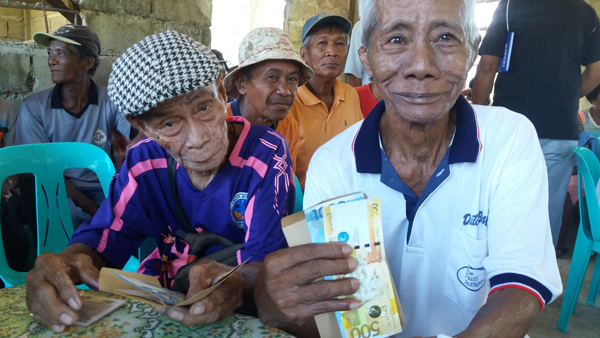
Credit: COSE Pinukpuk, Kalinga (24 September 2018) - Coalition of Services to the Eldery, a national NGO, and HelpAge provided emergency cash assistance to older people in remote areas affected by the typhoons.
Jose, 85 years old, and his wife Modesta Sagnawa, 83 years old, were among those who received cash assistance from COSE, HelpAge, and Age International in Pinukpuk, Kalinga. Jose has just one leg and is dependent on crutches to move about, while Modesta has a visual impairment. Dependent on their grandchildren and a monthly pension of PHP500 ($10) each, Modesta would make broom reeds three times a week for additional income. “This money will help us buy the medicines we need for now,” she said. “Since the typhoon devastated our fields, I’m not sure how long I’ll be unable to collect the reeds I need to earn my extra income.”
Lourdes Ayadi, 68 years old, lives in Itogon, Benguet, where she leads an organization of senior citizens to protect their ancestral lands from large-scale commercial mining. Before the typhoons, they survived on meagre earnings from their incomes from small-scale mining and farming, typical in their community. The members share their harvests communally, and sell the excess to neighbouring villages. Typhoon Mangkhut damaged her house, which is in a landslide prone area. They lost the sources of their incomes and increases in commodity prices mean they face even more difficulty purchasing their everyday needs. “The cash assistance we’ve received will help us buy medicines and food while we try to rebuild our community,” she said.
Maricel, who has a physical impairment, relied on her husband as the sole income-earner for the family in Ilocos Sur. But, after the typhoons, he lost his source of livelihood. Through a cash intervention as part of a community-based inclusive development initiative by CBM in partnership with Norfil Foundation, Maricel was able to launch a micro-business making dulce de leche spread, which she sells in her community to help her and her husband meet their daily needs. In addition to cash, CBM and Norfil have helped rehabilitate 100 damaged homes in Ilocos Sur, focusing on improving the quality of life of persons with disabilities.
Possible impact of El Niño
Farmers in northern Luzon are especially vulnerable to the coming El Niño due to the compounded damage they have received from these recent typhoons. Forecasts also predict that the impacts of the El Niño event will be most severe in this area.
With the onset expected to occur between in December, the recovery of farms in northern Luzon made it necessary for farmers to immediately start planting to avoid the peak impact of the El Niño, expected in March and April 2019. The National Agricultural Drought Monitor also indicates drought along the central and eastern parts of Luzon. Regional agricultural authorities are monitoring the development while they plan for subsequent actions.
FAO utilized an early warning system to build evidence and confidence about the development and potential impact of El Niño across the Philippines. The system is providing timely information to local and regional authorities and humanitarian partners to ensure early actions are planned and implement on the ground to mitigate the anticipated impact.
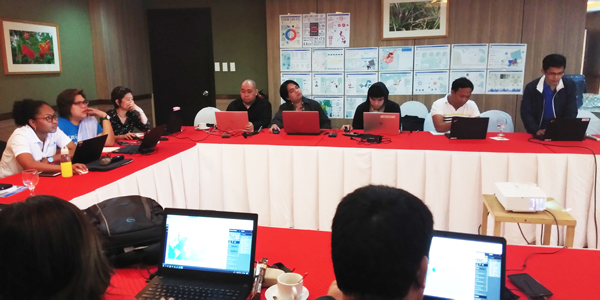
Credit: OCHA/L. Aporto (12 July 2018) - The OCHA information management team conducts a workshop for the Office of Civil defense technical staff.
Response preparedness and capacity building with partners in vulnerable areas
In 2018, a priority activity of OCHA with support from UNICEF has been to help build the capacity of government partners in hazard prone areas, particularly on needs assessment, data processing, visualization and community engagement.
During the first few days of a sudden onset emergency, managing information coming in from numerous sources and translating this to useful data is a daunting task. With the Philippines regularly experiencing tropical cyclones, floodings, earthquakes, landslides, volcanic eruptions and other natural disasters, data preparedness and processing tools can provide information for decision makers in preparing and responding to emergencies.
Data preparedness and visualization for government partners
OCHA facilitated a series of training-workshops for the officials and staff of the Office of Civil Defense (OCD) National and Regional Offices. Three training-workshops were conducted for the national OCD staff held in Tagaytay City. Regional staff in Luzon (Regions I, II, III, IVA, V, Cordillera Administrative Region and National Capital Region) held their training in Clark, Pampanga, while regional staff in Visayas and Mindanao (Region IVB, VI, VII, VIII, IX, X, XI, XII, Autonomous Region in Muslim Mindanao and Caraga) met in Cebu City. The workshops focused on data processing and visualization, and OCD staff devised improved data templates, better understanding of data flow and generation of 1 to 2-page snapshot visualizations.
OCD Operations Service Division is committed to improving its capacity for data preparedness and presentation. Lessons gained from the workshop were applied during the preparation of humanitarian snapshots by OCD staff prior to and during the onset of Typhoons Mangkhut and Yutu, which were presented during the National Disaster Risk Reduction and Management Council (NDRRMC) meetings. Participants shared that the training would help them generate reports and visualizations from data they receive from clusters and agencies. In addition, OCD also started a review of the Rapid Damage and Needs Analysis (RDANA) form, a disaster response tool that is used during a disaster, and is considering the use of KoboToolbox, a mobile tool for field data collection during rapid assessments.
A corresponding training was also conducted with three provincial local government units (LGUs) targeting provincial disaster risk reduction officers (PDRRMO) and municipal disaster risk reduction officers (MDRRMO). Workshops were conducted in the provinces of Albay, Lanao del Norte and Benguet and focused on improving local data management and reporting.
Partnerships can go a long way in helping government partners improve their data management especially in emergency response. OCHA is committed to continue with the conduct of similar activities in 2019 in partnership with other UN agencies.
Pre-crisis consultation mapping for large-scale typhoon and volcano eruption
Understanding life-saving and evolving needs of at-risk people even before a disaster strikes is crucial. Pre-crisis information mapping and consultation with the community are critical to the process of planning. This process allows humanitarian actors to identify minimum resources necessary to augment or complement the capacities of the national government.
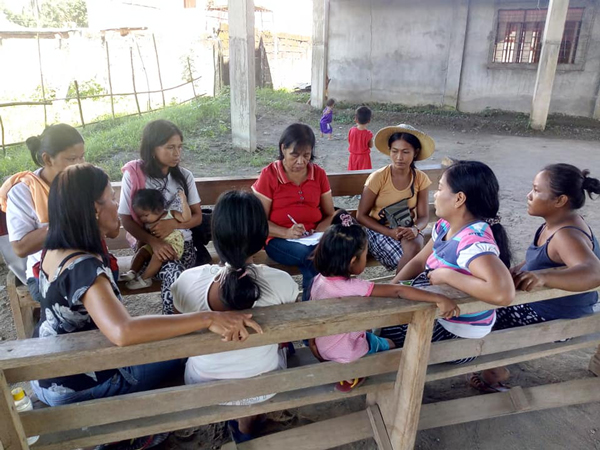
Credit: OCHA/G. Arevalo Tuguegarao, Cagayan (11 December 2018) - A focus group discussion with pregnant mother and lactating women in Barangay Abariongan Ruar. Women, children are one of the most vulnerable populations during disasters.
A series of pre-crisis consultation mapping activities for large-scale typhoon and volcano eruption were conducted from August-December 2018. The four-month extensive consultation process focuses on two possible emergencies such as a typhoon scenario with an intensity equal to or greater than a super typhoon and the potentially catastrophic impact of a Mayon volcano eruption in Legaspi, Albay.
More than 800 people in four at-risk provinces were consulted on their humanitarian assistance priorities, information needs and preferred communication channels, and identified accountability mechanisms following these phases of humanitarian response: after 72-hours, one-week, one-month and three-to-six months. Among those consulted were vulnerable groups such as children, women, elderly, persons with disabilities, farmers and fisher folks and the indigenous people. The survey uses a quali-quantitative approach through household surveys using mobile data collection (KoboToolbox), key-informant interviews and focus-group discussion.
The conduct of the pre-crisis assessment is part of the Community of Practice on Community Engagement’s (CoPCE) support to the Humanitarian Country Team’s large-scale typhoon contingency plan and to strengthen its support should Mayon volcano erupt in the near future. This is also part of testing the CoPCE’s preparedness and response operations to highlight both the life-saving and evolving needs of the affected or at-risk communities. Aside from OCHA, CoPCE members such as CARE, Christian Aid, Humanity & Inclusion, NASSA/Caritas and UNICEF became instrumental in making the conduct of the pre-crisis assessment a success. In 2017, the CoPCE also supported the HCT in the pre-crisis consultation mapping for Metro Manila 7.2 magnitude earthquake.
GIDAS and indigenous people
The pre-crisis survey focused on geographically isolated and depressed areas (GIDAS) in Northern Luzon and two island barangays in the Visayas region.
For Northern Luzon, the team went to landslide-prone areas of Barangay Apatan in Pinukpuk, Kalinga and Cagayan river-based barangays of Abariongan Ruar and Balagan in Sto.Nino, Tuguegarao, Cagayan. Some vulnerable and at-risk areas in the area are considered difficult to access by land and the said areas could be totally isolated in case of a disaster, which reinforces the need to conduct pre-crisis information mapping and consultation in the region.
For Visayas, areas covered were two island barangays of San Juan and Ermita in San Carlos City in Negros Occidental. Several island areas in the Visayas, are identified not only as vulnerable due to climate change related impacts but are also considered as geographically isolated and depressed.
In Legaspi, Albay, pilot areas were those identified as prone to lahar, rock debris and ash fall within 6-8 kilometer danger zone. While the capacity of provincial government is strong through the Albay Public Safety Management Office (APSEMO) there is a need to address the evolving needs of local residents that will most likely experience protracted displacement in the evacuation centres.
Publication of results
The pre-crisis survey is in the process of consolidation and validation by partners, and results will be available in February 2019.